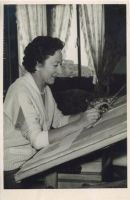Matilde Ucelay Maórtua
Biography
Matilde Ucelay Maórtua was born to a professional and liberal bourgeois family in Madrid. She was the oldest of four sisters who received an education that was quite exceptional at that time. First they were educated at home and then they attended to “Instituto Escuela”, a public institution that became one of the symbols of the Spanish educational reform promoting pedagogical changes in the country such as coeducation. Their mother, Pura Maórtua, passed on to young Matilde her interest in arts, especially music, and she was herself a pioneer in the feminist demands that very cautiously started to appear among women belonging to intellectual bourgeois circles.
Those who knew her tell that Matilde Ucelay wanted to become an architect as a child. She was convinced that women could improve the profession, particularly in relation to housing architecture. In 1931 she joined the School of Architecture of Madrid, where only three more women were studying during those years. She was generally accepted by both students and professors, only a few exceptions, and stood out as a very diligent student. She was actually able to finish her studies one year earlier, in 1936, just a few days before the beginning of the Spanish Civil War (1936-39), becoming the first female architect in Spain.
Ucelay’s personal and professional life was marked by the military uprising, then the Civil War and finally the dictatorship. Her modest support to the legitimate republican government would cost her two long judicial processes -first military and then civil- which led to absolute disqualification for the public professional practise, 5 years of disqualification for private practise and a considerable sanction. That was an exemplary punishment, she was the only women on that judgement, and suffered the proportionally greatest sentence and a subsequent process to erase her presence within the profession. Matilde Ucelay represented a female model that was very different from the Francoist ideology one.
After the Civil War and the exile years in Valencia during the conflict, Ucelay started her professional practise in Madrid, combining architecture with her role as wife and mother of two children. She could start meeting clients thanks to her social status –first from her family, then mostly women or foreigners- and earned the respect of those who worked with her through a meticulous and committed work along the entire architectural process. Matilde Ucelay’s architecture is detail-oriented and quality made, she was able to combine client’s brief and her own respect for the profession. As a consequence of the social context in Spain, Ucelay had to compartmentalise her life in two worlds: professional and personal. She tried to give the best response according to the context, being a passionate and dedicated architect and a woman belonging to her social circle, always beautifully dressed, a good cook and an excellent hostess to friends.
Although in 2006 she was awarded the most important architectural recognition in Spain, The National Prize of Architecture, Matilde Ucelay is not yet a popular name among Spanish architects. She died in Madrid in 2008, at the age of 96 years old.
Chronology
1912: She is born in Madrid
1926: Her mother, Pura Maórtua, founds Lyceum Club, one of the first women associations in Spain.
1931: Joins the School of Architecture of Madrid.
1934: Travels to Russia, via Paris and Berlin. The tour was organized by Soviet Union agency Intourist. She travelled with José Ruiz-Castillo, her future husband, and some friends.
1936: She finishes her architecture studies, a year earlier. She was honoured by her classmates for being the first female architect in Spain.
1936-39: She spent the Civil War in Valencia, together with her family and boyfriend, where married and had her first son.
1939: She comes back to Madrid. The couple establishes their residence at the penthouse on Alcalà Street. Matilde Ucelays sets a small office at the living-room where she will work until retirement in 1981.
1939-1954: Overall period of both judicial processes. She suffered the proportionally greatest sentence. She was sentenced to absolute disqualification for the public professional practise, 5 years of disqualification for private practise and she was also fined the sum of 30.000 pesetas.
1940: First work. Extension of a country house in La Huerta del Venado (Segovia). It was commissioned by her mother-in-law, Paz Basala.
1950’s: Years of interesting correspondence with her good friend and former classmate, Félix Candela.
1981: She retires from professional practise.
1998: She is honoured by La Mujer Construye association.
2003: The Official College of Architects of Madrid (COAM) names her “Honorary Collegiate”.
2004: The sanctions imposed in 1942 are set aside. Ucelay would have been allowed to work in the public sector.
2006: She is awarded the National Prize of Architecture.
2008: She dies in Madrid, at the age of 96.
Sources of information:
- SÁNCHEZ DE MADARIAGA, Inés (Dir). 2012. Matilde Ucelay Maórtua. Una vida en construcción. Premio Nacional de Arquitectura. Madrid: Ministerio de Fomento. ISBN: 978-84-498-0920-0
- SÁNCHEZ DE MADARIAGA, INÉS (2010): “Amigos del alma. Matilde Ucelay y Félix Candela. La incautación del Colegio de Madrid y la represión de los arquitectos durante el franquismo”, in Cueto Ruiz-Funes, J.-I. (ed.) Félix Candela 1910-2010, Instituto Valenciano de Arte Moderno-Sociedad Estatal de conmemoraciones Culturales, pp. 121-138. ISBN: 978-84-92827-95-4.
- SÁNCHEZ DE MADARIAGA, Inés (2008): “El papel de las mujeres en la arquitectura y el urbanismo, de Matilde Ucelay a la primera generación universitaria en paridad”, in Leboreiro, Marian (ed.), La arquitectura y el urbanismo desde la perspectiva de las arquitectas, Ministerio de Vivienda- ETSAM, Madrid, pp. 69-77. ISBN: 978-84-691-9168-2.
- VÍLCHEZ, Javier (2012): Matilde Ucelay. Primera mujer arquitecta de España. Doctoral thesis. Universidad de Granada. Granada. ISBN: 978-84-9028-494-0
Photo © Familia Ruiz-Castillo




